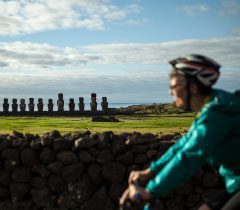Easter Island
Easter Island, Chile
The Areas we explore
Areas we explore - Easter Island
Poike
Together, wind, sea and fire have carved a unique identity for each corner of the island, all contrasted against the ever-clear pantone of isolation.
This zone is the tip of a vast volcanic peninsula and the island’s easternmost point. Its geographic position has caused severe erosion, which drove its inhabitants to abandon the area over 600 years ago. As a result, this zone is of unique, untouched beauty.
The Poike zone, named after the oldest volcano on the island, offers some of its most unusual sceneries, with harsh conditions evidencing how the Rapa Nui is eroded by sea and water, one of the its people’s most pressing ecological predicaments.
The South
The island’s very existence is testament to a battle fought long ago between fire and sea.
This zone comprises the south-facing lowlands, where four territorial clan divisions and numerous archeological vestiges, including agricultural tools and ceremonial instruments, have allowed researchers to understand and reconstruct important clues of Rapa Nui’s past.
The Akahanga sector is of particular interest in this zone, as are the dramatic waves caused by intense oceanic wind currents
Lava Flows
From water came lava and from lava came land. Tales to be told only by the elements themselves.
As the byproduct of a series of volcanic eruptions, Rapa Nui is dotted with vestiges of its geographic past. Numerous rock wells and caverns, most of which are important sources of water, account for this zone’s once high population. The island’s most recent lava movements have been found here, originating from the nearby Maunga Terevaka, Rapa Nui’s largest volcano. Accordingly, the surrounding landscape is overall irregular and interrupted by vestiges of volcanic activity, which also characterize the zone’s memorable skyline.
Rano Kau
As one of the volcanoes from which the island originated, Rano Kau’s vigilant gaze defines Rapa Nui’s enigmatic cultural landscape.
Located in Southeastern Rapa Nui, the dormant volcano’s lowlands host a substantial part of the population. Towards the coast, Hanga Roa bay has offered shelter to nomad vessels throughout history. As well as various settlement types, this zone’s coastal area is home to numerous ceremonial archaeological sites, such as the Vinapu ahu, one of the largest in its kind. Not to be missed are the volcano’s gigantic crater lake and the Orongo ceremonial village, where a large part of the island’s heritage is preserved, studied and accessed by visitors.
Explorations in Rano Kau >Miru
We climb mountains not only on foot, but also in heart and mind, often reaching places reserved for only a few sky-scraping birds and travelers in search of movement and contemplation alike.
At 1,664.73 ft, the Maunga Terevaka, is Rapa Nui’s highest peak, providing a lookout so isolated that you can distinguish our planet’s curvature in the horizon. Given its prominence, this zone was once occupied by the Miru aristocracy in the pre-Christian era.
The zone’s lowlands, which include the island’s north and northeastern coasts, host many archaeological vestiges, most of which remain intact and have therefore been vital clues in understanding the island’s mysterious past. This zone also includes Anakena, Rapa Nui’s political and cultural capital, where numerous restored monuments can be found.
Hotu Iti
Hotu ‘Iti is the zone located on the Rano Raraku volcano’s slopes and plains. Its role in Rapa nui culture is of upmost significance, as it is here where most moai were quarried from.
Given the zone’s socio-cultural significance, some of the most remarkable Rapanui archaeological vestiges can be found within, including the Ahu Tongariki, which was damaged by civil wars and a powerful tsunami. The ceremonial site was restored in the 90s and now includes fifteen moai, all of which face the sunset during the summer solstice.
Moana
A tiny speck on the infinite blue Pacific Ocean. The definition of remote.
The ocean plays a key role in Rapanui culture. Not only did the island’s first inhabitants arrive by sea, but it this isolation also kept generations to come from ever leaving. Furthermore, seafood and fish are an important part of Rapa Nui’s culinary heritage to this day.
The waters surrounding the island offer a unique clarity for sea explorations. This is due to low levels of plankton in the area, which also cause a lower number of larger species to be found. Regardless, however, marine fauna on Easter Island is endemic to its waters, which is why scuba diving and snorkeling are highly recommended.

